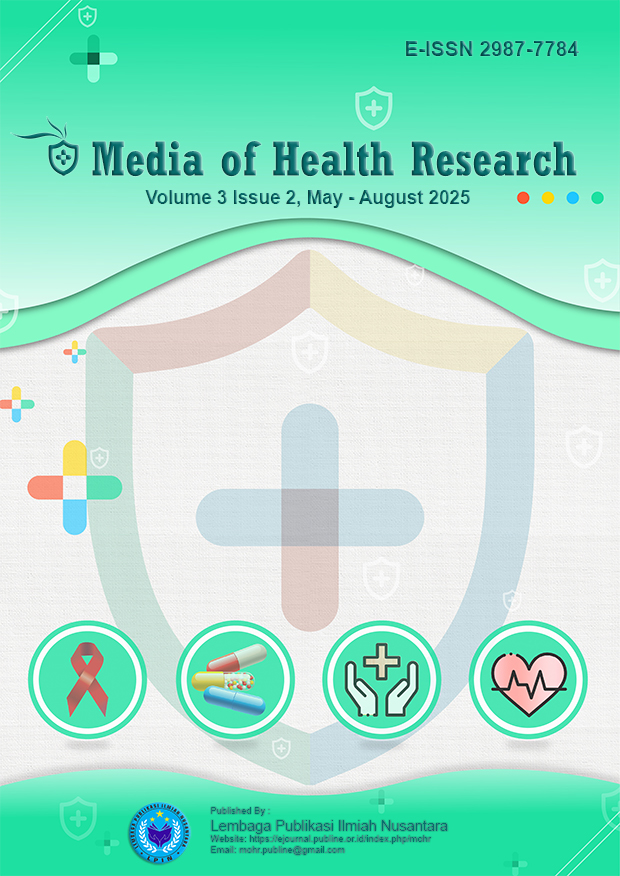Analysis of the Relationship Between Dietary Patterns and the Risk of Non-Communicable Diseases Among Urban Adolescents in Mataram City, Lombok
DOI:
https://doi.org/10.70716/mohr.v3i2.244Keywords:
dietary patterns, non-communicable diseases, adolescents, Mataram City, urban nutritionAbstract
Non-communicable diseases (NCDs), including obesity, diabetes, and hypertension, are becoming increasingly prevalent among adolescents, especially in urban areas experiencing rapid lifestyle changes. This study aims to analyze the relationship between dietary patterns and the risk of NCDs among adolescents in Mataram City, Lombok. A cross-sectional study was conducted involving 300 high school students aged 15–18 years from five schools across Mataram. Data collection included validated food frequency questionnaires (FFQ), anthropometric measurements, and structured interviews to assess lifestyle factors. Dietary patterns were classified into three categories: healthy (high intake of fruits, vegetables, and whole grains), mixed (moderate intake of processed and sugary foods), and unhealthy (frequent consumption of fast food, sweetened beverages, and high-fat snacks). Risk indicators such as Body Mass Index (BMI), blood pressure, and family history of NCDs were analyzed using chi-square tests and logistic regression. The results indicated a significant association between unhealthy dietary patterns and elevated BMI (p < 0.01) and increased systolic blood pressure (p < 0.05). Adolescents with unhealthy eating habits were found to be 2.7 times more likely to be at risk for NCDs compared to their peers with healthy diets (OR = 2.7; 95% CI: 1.7–4.3). These findings emphasize the urgent need for targeted nutritional education and health promotion strategies in urban schools within Mataram. Early interventions can play a crucial role in reducing the long-term burden of NCDs among the youth population.
Downloads
References
Amrita, N. N. W. A., Utami, N. W. A., & Adhi, K. T. (2022). Determinants of late adolescent nutritional status in Indonesia: a nation-wide cross-sectional survey. Nutrition & Food Science, 52(5), 801–813. https://doi.org/10.1108/NFS-07-2021-0235
Bhutta, Z. A., et al. (2013). Evidence-based interventions for improvement of maternal and child nutrition. The Lancet, 382(9890), 452–477. https://doi.org/10.1016/S0140-6736(25)01427-8
Contento, I. R. (2011). Nutrition education: Linking research, theory, and practice. Jones & Bartlett Publishers.
Drewnowski, A., & Specter, S. E. (2004). Poverty and obesity: the role of energy density and energy costs. The American Journal of Clinical Nutrition, 79(1), 6–16. https://doi.org/10.1093/ajcn/79.1.6
Glanz, K., Rimer, B. K., & Viswanath, K. (2008). Health behavior and health education: Theory, research, and practice. John Wiley & Sons.
Hu, F. B. (2002). Dietary pattern analysis: a new direction in nutritional epidemiology. Current Opinion in Lipidology, 13(1), 3–9.
Jamison, D. T., et al. (2013). Global health 2035: a world converging within a generation. The Lancet, 382(9908), 1898–1955. https://doi.org/10.1016/S0140-6736(25)01427-8
Kremers, S. P., et al. (2006). Environmental influences on energy balance-related behaviors: a dual-process view. International Journal of Behavioral Nutrition and Physical Activity, 3(1), 9. https://doi.org/10.1186/1479-5868-3-9
Ng, M., et al. (2014). Global, regional, and national prevalence of overweight and obesity in children and adults during 1980–2013. The Lancet, 384(9945), 766–781. https://doi.org/10.1016/S0140-6736(25)01427-8
Nurwanti, E., Hadi, H., Chang, J. S., Chao, J. C. J., Paramashanti, B. A., Gittelsohn, J., & Bai, C. H. (2019). Rural–urban differences in dietary behavior and obesity: Results of the riskesdas study in 10–18-year-old Indonesian children and adolescents. Nutrients, 11(11), 2813. https://doi.org/10.3390/nu11112813
Patton, G. C., et al. (2016). Our future: a Lancet commission on adolescent health and wellbeing. The Lancet, 387(10036), 2423–2478. https://doi.org/10.1016/S0140-6736(25)01427-8
Perez-Rodrigo, C., & Aranceta, J. (2003). Nutrition education in schools: experiences and challenges. European Journal of Clinical Nutrition, 57, S82–S85. https://doi.org/10.1038/sj.ejcn.1601824
Popkin, B. M. (2017). Relationship between shifts in food system dynamics and acceleration of the global nutrition transition. Nutrition Reviews, 75(2), 73–82. https://doi.org/10.1093/nutrit/nuw064
Popkin, B. M., & Reardon, T. (2018). Obesity and the food system transformation in Latin America. Obesity Reviews, 19(8), 1028–1064. https://doi.org/10.1111/obr.12694
Rachmi, C. N., Jusril, H., Ariawan, I., Beal, T., & Sutrisna, A. (2021). Eating behaviour of Indonesian adolescents: a systematic review of the literature. Public Health Nutrition, 24(S2). https://doi.org/10.1017/S1368980020002876
Sawyer, S. M., et al. (2012). Adolescence: a foundation for future health. The Lancet, 379(9826), 1630–1640. https://doi.org/10.1016/S0140-6736(12)60072-5
Story, M., Neumark-Sztainer, D., & French, S. (2002). Individual and environmental influences on adolescent eating behaviors. Journal of the American Dietetic Association, 102(3), S40–S51. https://doi.org/10.1016/S0002-8223(02)90421-9
UNICEF. (2021). The State of the World's Children 2021: On My Mind—Promoting, protecting and caring for children’s mental health.
Verstraeten, R., Leroy, J. L., Pieniak, Z., Ochoa-Avilès, A., Holdsworth, M., Verbeke, W., & Kolsteren, P. (2016). Individual and environmental factors influencing adolescents’ dietary behavior in low-and middle-income settings. PLoS One, 11(7), e0157744. https://doi.org/10.1371/journal.pone.0157744
World Health Organization. (2020). Noncommunicable diseases: Key facts. https://www.who.int/news-room/fact-sheets/detail/noncommunicable-diseases
World Health Organization. (2021). Global status report on noncommunicable diseases 2021. Geneva: WHO.
Downloads
Published
How to Cite
Issue
Section
License
Copyright (c) 2025 Lalu Hendra Saputra

This work is licensed under a Creative Commons Attribution-ShareAlike 4.0 International License.











